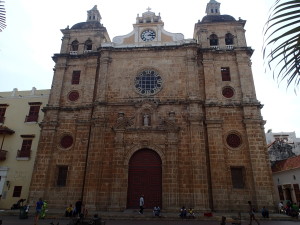After we visited the SOS projects in Cartagena it was time to do some maintenance on the bikes (they both needed an oil change). Ludwig’s place was ideal for that. He had a drain pan and a little concrete pad to do the work. But as always it was very hot and humid, but it had to be done.
Next day was time to explore historic Cartagena in more detail – the old city and the old fortress. The Castillo San Felipe de Barajas is a fortress in the city of Cartagena, Colombia. The castle is located on the Hill of San Lázaro in a strategic location, dominating approaches to the city by land or sea. It was built by the Spanish during the colonial era. Construction began in the year 1536, and it was originally known as the Castillo de San Lázaro,
The fortress is massive and was considered the strongest Spanish fortress ever build.
In March 1741 the city endured a large-scale attack by British and American colonial troops led by Admiral Edward Vernon, (1684–1757), who arrived at Cartagena with a massive fleet of 186 ships and 23,600 men, including 12,000 infantry, against only 6 Spanish ships and less than 6,000 men, in an action known as the Battle of Cartagena de Indias. Blas de Lezo the Spanish sea farer, with only one eye, one leg and one hand, was one of the military leaders that defended the city from Admiral Vernon in 1741.The siege was broken off due to the start of the tropical rainy season, after weeks of intense fighting in which the British landing party was successfully repelled by the Spanish and native forces led by commander General Blas de Lezo y Olavarrieta, (1689 – aftermaths of the Cartagena battle, 1741), a Basque from the Gipuzkoa lands, (Spain).
Heavy British casualties were compounded by diseases such as yellow fever. This victory prolonged Spain’s control of the Caribbean waters, which helped secure its large Empire until the 19th century.
If that battle would have ended differently all of South America would probably speak English now – that is pleasant thought – would make life a little easier for us :).
Anyway the old part of Cartagena is really beautiful, but what a difference here between rich and poor. Colombia is actually in the top ten of countries with the widest gap between rich and poor. Next day was time to say good bye to Captain Ludwig and his extended family and move on to Santa Marta at the Caribbean north coast.
Santa Marta is another colonial town that faded under new concrete buildings, but it is still an attractive destination for exploring the beaches in the area and the Tayrona National Park.
We stayed at Hostal Miramar in the downtown area near the sea side, which was affordable and we could park the bikes right in the court-yard. We had hoped to find a little bit cooler temperature here, but it was as hot and humid as in Cartagena.
So we relaxed a couple of days here and went one day on a hike in Tayrona National Park. We took a bus early at 6 AM to Calabazo to start our 15 km hike to one Tayrona village (Pueblito) and explore some nice beaches along the sea (Cabo San Juan and others). As nice as the jungle and beaches are it was very hot that day and we were totally spent at the end of the day, barely able to climb anymore – probably a sign as well that we are out of shape.
Well we survived and recovered one more day in Santa Marta before going south towards the mountains to San Gil in the search for cooler temperature.
So far here are the top three things I like about Colombia:
- People are very kind and friendly
- Women are stunningly beautiful (of course not as beautiful as my wife)
- All toll roads are free for motorcycles
Cheers, Heinz










Heinz, I’m stealing your identity here. I’m pretty sure you won’t want to return anyway.